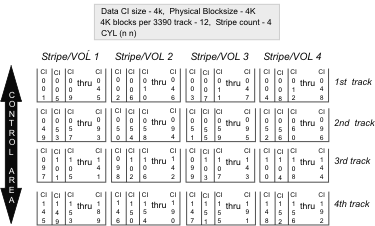 z/OS DFSMS Using Data Sets
z/OS DFSMS Using Data Sets
 z/OS DFSMS Using Data Sets
z/OS DFSMS Using Data Sets
|
Previous topic |
Next topic |
Contents |
Contact z/OS |
Library |
PDF
Layering Concept for Data Striping z/OS DFSMS Using Data Sets SC23-6855-00 |
|
|
Layering is a concept generally associated with data that is striped.
A layer in a striped environment is defined as the relationship of
the volumes that make up the total number of stripes. That is, those
volumes that will participate as part of the I/O packet. Once any
volume or volumes, up to a maximum of stripe count, composing this
I/O packet changes, this constitutes another layer. As relates to
striped data, the volumes that constitute this I/O packet should be
viewed in the same context as a single volume data set, as opposed
to multivolume if the data were not striped. Once the data set extends
to a second layer, this would be analogous to a multivolume nonstriped
data set. Again, the definition of striped is a stripe count greater
than 1. The sequential access method (SAM) does not support the concept
of multi-layering. VSAM supports multi-layering. Figure 1 shows an example of the concept of layering
with a four-stripe data set.
Figure 1. Layering (Four-Stripe Data Set)
 


|
 Copyright IBM Corporation 1990, 2014 Copyright IBM Corporation 1990, 2014 |